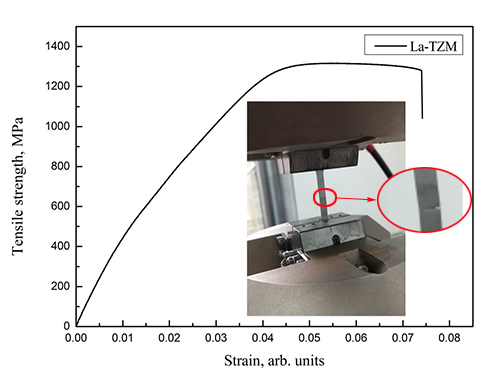
以La-TZM合金为研究对象,采用粉末冶金工艺制备了稀土镧掺杂钼钛锆(La-TZM)合金粉末,将合金粉末在180MPa冷等静压10min,1950℃烧结制备成烧结坯料,实验试样在线切割后,试样表面经过180# - 3000#砂纸打磨后继续使用1.5μm的金刚石抛光剂对其进行抛光,以完全消除划痕。使用铁氰化钾、氢氧化钠和水(1:1:10)配置Murakami腐蚀液进行擦拭腐蚀。通过样品的SEM显微组织,统计样品的晶粒尺寸、第二相尺寸、形貌和分布形式。使用HSC Chemistry对TZM合金烧结过程的热力学进行了计算。所用热重-质谱联用分析仪的型号为珀金埃尔默 TL2000,测试的温度为25℃~1200℃,加热速率为20℃/min,测试环境为氩气气氛,检测的气体为H2,H2O,CO,CO2。对合金粉末中第二相的形成结果进行了计算和检测分析。计算了La-TZM合金组分中不同合金化物质可能发生的18中反应在25~1950℃热力学基布斯自由能的变化,每隔100℃检测了La-TZM合金粉末样品在0~1200℃的物相变化,检测了25~1200℃合金粉末的热重-质谱变化,采用bramfit二维错配度计算了第二相界面错配度,固体电子理论计算第二相界面电子密度差。
La-tzm alloy powder was prepared by powder metallurgy process. The powder was sintered into sintered blank at 180MPa cold isostatic pressing for 10min at 1950℃. The experimental sample was cut by wire. The surface of the sample was polished with 180# to 3000# sandpaper and then polished with 1.5μm diamond polishing agent to completely eliminate scratches. Murakami etch solution was used for wipe etching using potassium ferricyanide, sodium hydroxide and water (1:1:10). The grain size, second phase size, morphology and distribution form of the sample were analyzed by SEM. The thermodynamics of TZM alloy sintering process was calculated by HSC Chemistry. The model of the THERMOgravimetric mass spectrometry analyzer was Perkinelmer TL2000. The test temperature was 25℃~1200℃, and the heating rate was 20℃/min. The test environment was argon atmosphere, and the detected gases were H2, H2O, CO and CO2. The results of the formation of the second phase in alloy powder were calculated and analyzed. The thermodynamic kibs free energy changes of different alloying substances in La-TZM alloy components were calculated at 25~1950℃. The phase changes of La-TZM alloy powder samples were detected at 0~1200℃ every 100℃. The thermogravimetric mass spectrometry (TG-MS) changes of la-TZM alloy powder samples were detected at 25~1200℃. The second phase interface mismatch was calculated by using bramfit two-dimensional mismatch, and the second phase interface electron density difference was calculated by solid state electron theory.